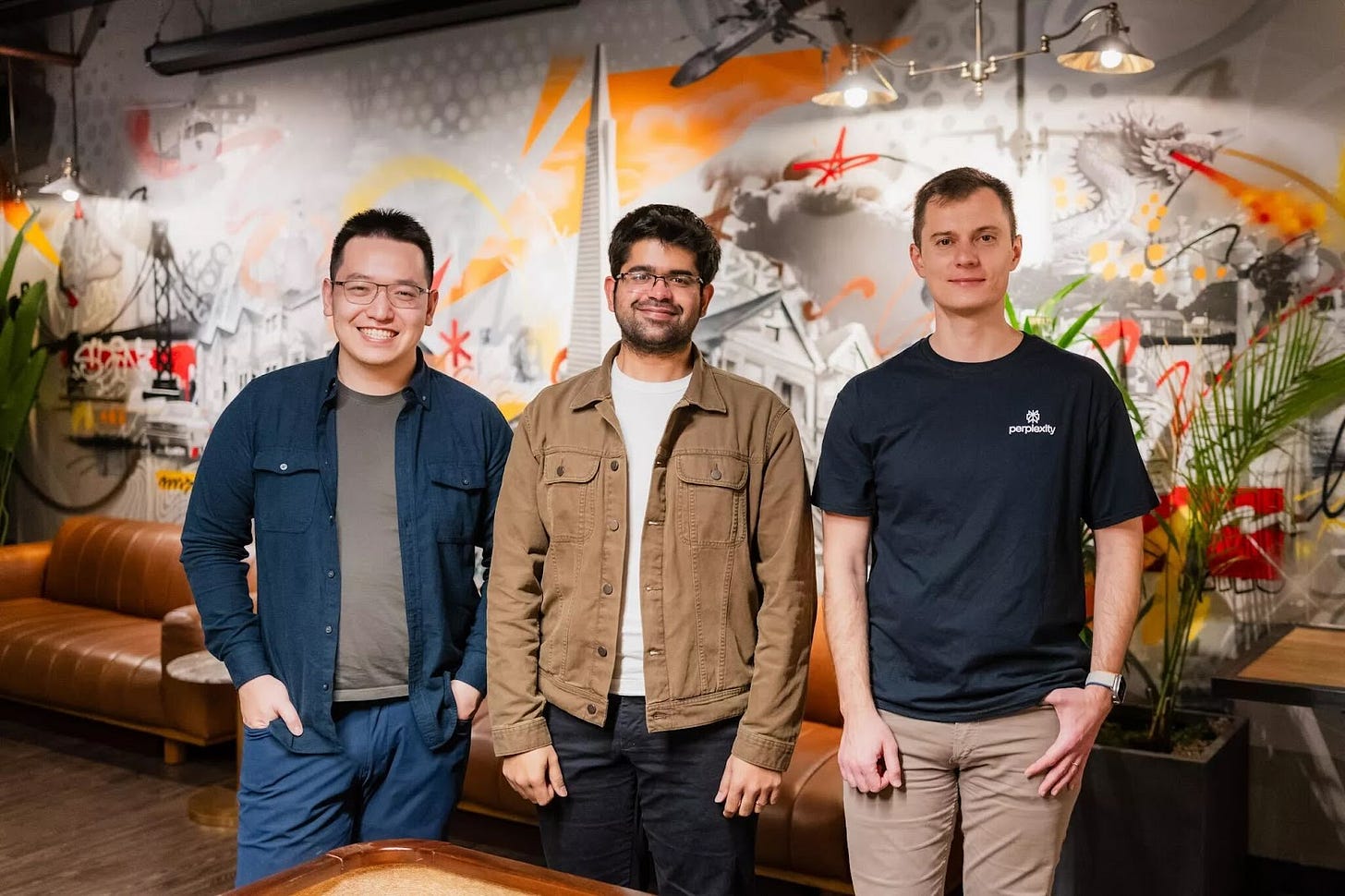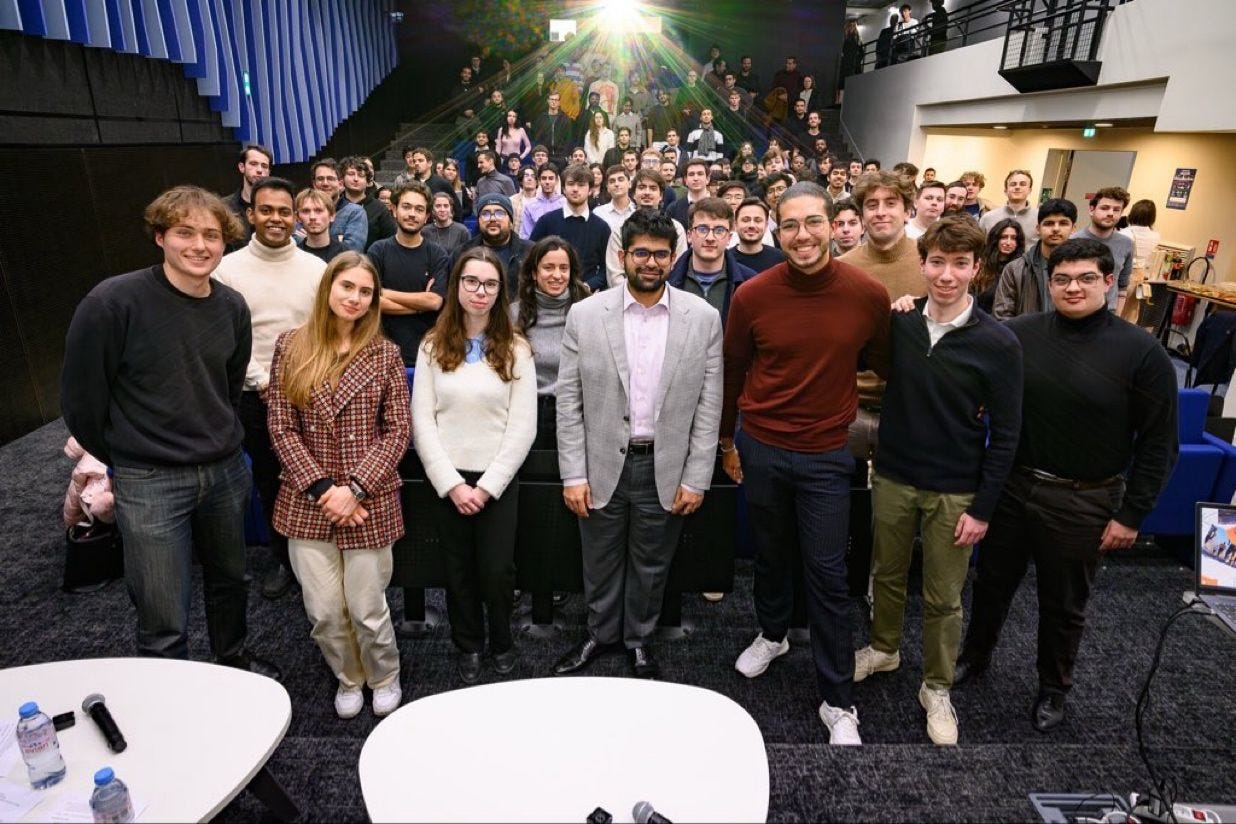ANOTHER DAY—ANOTHER STARTUP STORY
Hi founders, 👋
We’re opening up sponsorship opportunities for early-stage founders who want to showcase their startups to a highly engaged and targeted audience. Please check out more details about this sponsorship at the link below:
You open Google to find an answer.
You type your question.
You get... links.
Ten blue ones.
Maybe ads.
Maybe SEO-optimized blogs that say a lot but don’t really help.
So you click one. Then another. And another.
You scroll. You skim. You search inside the search.
Half an hour later, you're still piecing things together from Reddit threads, outdated forums, and docs buried on page 4.
All you wanted was a straight answer.
But the internet made you work for it.
That’s the problem.
Search stopped being about finding answers and started being about finding where the answer might be.
In 2022, two people felt that pain too.
And they asked a simple question:
What if search actually gave you the answer, right away?
Not a list of websites.
Not a maze.
Just the knowledge you’re looking for, clearly explained.
And that’s how Perplexity was born.
About the company
Perplexity AI is an AI-powered answer engine that combines the power of large language models with real-time web search to provide direct, cited answers to user questions instead of just links. It’s designed to act like a knowledgeable assistant, delivering accurate, conversational, and source-backed information across a wide range of topics.
Launched in 2022, Perplexity is often called an “AI-native search engine” built from the ground up using models like GPT-4, Claude, and its own in-house tech. It’s used by students, researchers, developers, and everyday users who want to search faster, learn deeper, and trust the answers they get.
Meet the minds behind Perplexity AI?
Aravind Srinivas (Co-Founder & CEO)
Born on June 7, 1994, in India, Aravind's passion for technology led him to pursue advanced studies in computer science. He earned his Ph.D. from the University of California, Berkeley, focusing on AI and machine learning. During his academic journey, Aravind undertook research internships at leading tech organizations, including Google, DeepMind, and OpenAI, where he contributed to advancements in AI and machine learning. These experiences provided him with a comprehensive understanding of the AI landscape and inspired him to establish Perplexity AI, aiming to revolutionize the search engine industry by leveraging cutting-edge AI technologies.
Denis Yarats (Co-Founder & CTO)
Denis holds a Ph.D. in Artificial Intelligence from New York University, where his research encompassed reinforcement learning, deep learning, natural language processing, and robotics. His professional career includes roles as a research scientist at Facebook AI Research and as a machine learning engineer at Quora. Denis's extensive experience in AI system development and his commitment to advancing machine learning technologies have been instrumental in shaping Perplexity AI's technical direction.
Johnny Ho (Co-Founder & Chief Strategy Officer)
Johnny's academic background includes studies at Harvard University. Professionally, he has experience as a high-frequency trader at Tower Research Capital and as an engineer at Quora. Notably, Johnny is a distinguished competitive programmer, achieving three gold medals at the International Olympiad in Informatics (IOI), including a perfect score in 2012. His expertise in algorithmic problem-solving and strategic planning plays a crucial role in Perplexity AI's product development and strategic initiatives.
Andy Konwinski (Co-Founder & President)
Andy completed his Ph.D. in Computer Science at UC Berkeley, focusing on AI, data, and machine learning systems. He co-founded Databricks, where he led AI product development, contributing to the company's growth into a significant data analytics platform. At Perplexity AI, Andy's experience in building scalable data infrastructure and his entrepreneurial acumen are vital in steering the company's growth and operational strategies.
Together, these founders combine their diverse backgrounds and shared vision to redefine information retrieval on the internet. Their collective goal is to create an AI-native search engine that delivers direct, accurate, and conversational answers, transforming how users access and interact with information online.
The first build
The early days of Perplexity AI began in late 2022, when Aravind Srinivas, drawing from his research at OpenAI and Berkeley, built a simple prototype that answered questions with cited sources. It was raw, a hacked-together interface using OpenAI’s API, but it worked. Unlike traditional search engines or chatbots, Perplexity offered transparency. Every answer came with links. You could dig deeper, cross-check, explore.
This early version caught attention fast. Users described it as “having a nerdy friend who read the whole internet.” It wasn't just fast, it was trustworthy. The citation-first approach became its defining feature, setting it apart from ChatGPT’s “confident but wrong” responses.
Within months, growth accelerated. Perplexity went from being a quiet prototype to a product used by millions. As of early 2024, it boasted:
10 million monthly active users
100 million visits per month
Over 2 million mobile app downloads
Daily usage from founders, researchers, and students worldwide
By prioritizing accuracy and curiosity over pure flash, Perplexity quietly built a search experience that felt like the future.
How did they grow?
Here’s the crazy part: Perplexity didn’t spend millions on launch marketing.
It grew organically.
Why?
Because it solved a real problem and people told others.
Twitter/X, Reddit, Hacker News… tech people started switching their default search engine.
Startup founders began asking product questions.
Researchers used it for papers.
Developers used it to find bugs and solutions faster than StackOverflow.
And most importantly:
It never pretended to be the expert.
It pointed you to real sources.
It didn’t try to “replace” human knowledge it indexed it better.
How Perplexity AI makes money
There goal was to build something people actually wanted to use every day. Monetization came later, but when it did, it was simple and direct: a Pro plan.
They launched a subscription model.
For $20 a month, users got access to more powerful models (like GPT-4, Claude, Mistral), faster response times, unlimited usage, and some extra features tailored for researchers, analysts, and power users. No ads. No weird upsells. Just value for people who needed more from the product.
It was a quiet shift, but it worked. Instead of going the ad route, they leaned into the “tool for thinkers” identity. And it attracted the right kind of users — people who were willing to pay for speed, accuracy, and reliability.
The free version stayed open to everyone. That helped with word-of-mouth growth. But the Pro version started driving real revenue. It wasn’t about scale at all costs — it was about building a sustainable product with actual utility.
Early challenges
In the beginning, Perplexity had a clear idea but a hard time explaining it. People thought it was just another chatbot. It wasn’t. It was search, reimagined. But convincing users of that took time. Most were still typing questions into Google and clicking five different links. The idea of getting a direct, sourced answer felt too new, almost strange.
Under the hood, it was chaos. The system had to pull information from across the web, run it through models, and present a clear answer with citations — all in seconds. That’s a lot of moving parts. It broke often. Latency issues, irrelevant sources, answers that made no sense. The team was constantly fixing, tuning, rebuilding.
The hardest part was staying confident. They weren’t OpenAI. They didn’t have the glow of a billion-dollar brand. Every user they got was hard-earned. Every mistake cost them trust. And in a space where everyone was watching AI closely, they couldn’t afford many slips. So they kept shipping. Quietly. Relentlessly. Hoping people would notice.
MORE STORIES AND INSIGHTS:
What makes Perplexity AI stand out
There are a lot of AI tools out there. Most of them give you answers, but you never really know where those answers are coming from. Perplexity is different.
It shows you the sources. Right there, next to the answer. You can click and check for yourself. That one small thing builds a lot of trust.
Also, it’s fast. You type a question, it pulls info from across the internet, filters it, and gives a clean summary. No need to open ten tabs. No copy-pasting into ChatGPT. It just works.
Another thing, the experience feels light. No ads, no clutter, no extra stuff. Just you, your question, and a real answer.
It’s not trying to act like a human or replace you. It’s trying to help you learn faster and find real information. That’s what makes it useful. That’s why people are sticking with it.
Funding
Perplexity didn’t start out as a big, flashy company. But once people saw what it could do, investors started paying attention.
In January 2024, the company raised around 73 million dollars in a Series B round. Institutional Venture Partners led the funding, and even big names like Nvidia and Jeff Bezos joined in. That round pushed Perplexity’s valuation to about $520 million.
Just a few months later, in April, they raised another $62.7 million. This time it was led by Daniel Gross, the former head of AI at Y Combinator. More well-known investors came in, including Tobi Lutke from Shopify, Garry Tan, and Stan Druckenmiller. After this round, Perplexity was valued at just over one billion dollars.
Then came December. Perplexity raised a massive $500 million round. The same lead investor came back, along with firms like NEA, B Capital, T. Rowe Price, and once again, Nvidia. This time, their valuation jumped to $9 billion.
In less than a year, Perplexity grew from half a billion to almost ten billion in value. And they did it without ads, without gimmicks. Just by building something useful that helped people find real answers, faster.
Future plans
Perplexity AI is strategically planning to enhance its AI-driven search capabilities and expand its market presence. CEO Aravind Srinivas has articulated a vision to optimize various high-performing AI models, rather than relying on a single one, positioning Perplexity as a next-generation search engine. The company intends to utilize its funding to expand its team and continue innovating in the AI space.
In terms of product development, Perplexity AI has outlined a roadmap that includes incremental feature releases aimed at improving the user experience. These enhancements are designed to provide more accurate and efficient search results.
Financially, the company has demonstrated robust growth, with its valuation soaring from $500 million to $9 billion within a year.
Perplexity AI is reportedly in talks of securing an additional $1 billion in funding, which would elevate its valuation to $18 billion.
Addressing recent speculations about an initial public offering (IPO), CEO Aravind Srinivas has clarified that Perplexity AI has no plans to go public before 2028.
These strategic initiatives underscore Perplexity AI's commitment to advancing its technology and solidifying its position in the competitive AI search industry.
Perplexity for startups
Perplexity AI launched its Perplexity for Startups program on February 26, 2025.
It’s meant to help early-stage companies use their AI search engine and API without worrying about cost right away.
If your startup is eligible, you get six months of free access to Perplexity’s Enterprise Pro plan. That includes up to 50 seats for your team, so your whole team can use it for research, content, technical exploration, or anything else that needs fast, accurate answers.
They also give you $5,000 worth of API credits. This is useful if you’re building a product that needs access to search or summarization features,, especially for AI tools, knowledge platforms, or anything that works with real-time information.
But not every startup can apply. You have to meet a few conditions:
Your startup should be less than 5 years old.
You must have raised less than $20 million.
You need to be part of one of their approved partner programs (like from incubators, accelerators, or VCs).
And you shouldn’t already be paying for their enterprise plan.
It’s a pretty solid support program, especially if you're in that early stage where every tool needs to earn its keep. You can apply directly through their website, and they’ll review your startup before giving access.
What we can learn from Perplexity AI’s journey
1. Solve a real problem first, scale later.
Perplexity didn’t try to do everything at once. They focused on one thing making search better. Instead of throwing in features just to compete with Google or ChatGPT, they doubled down on giving fast, accurate, and cited answers. That focus made people stick around.
2. You don’t need to be loud to get attention.
They weren’t everywhere on social media or pushing ads. But good work travels. The product spoke for itself, and word of mouth did the rest. Sometimes the best kind of marketing is just building something people actually want to share.
3. Use the right tools, not just your own.
Instead of creating their own AI model from scratch, they used the best models already available GPT-4, Claude, Mistral and built on top of them. It saved them time and let them focus on the user experience.
4. Investors follow usefulness.
Their funding story shows that when you build something people genuinely use and trust, the money follows. They didn’t have to chase flashy features or hype. They focused on value.
5. You can grow without selling your soul.
Even at a $9 billion valuation, Perplexity hasn’t gone heavy on ads or cluttered the product with distractions. That’s rare. It’s a reminder that you can grow fast without compromising what made your product good in the first place.
Final thoughts
Perplexity shows that a product doesn’t need to be loud to make an impact.
By focusing on clarity, speed, and trust, it has quietly built a strong position in a space dominated by big players. Its growth wasn’t driven by viral trends or aggressive marketing, but by solving a real problem in a straightforward way. The team kept things simple, focused on the user experience, and let the product speak for itself. There’s something to learn in that especially for anyone building in tech today.
You don’t always need to chase attention.
Sometimes, just being genuinely useful is enough.
THANKS FOR READING!
- Gracie and Ayush from What A Startup













Funny story, I cancelled my Perplexity Pro subscription just three days ago.. and switched to (Google's) Gemini Advanced since it was included for free in my Google Workspace plan.